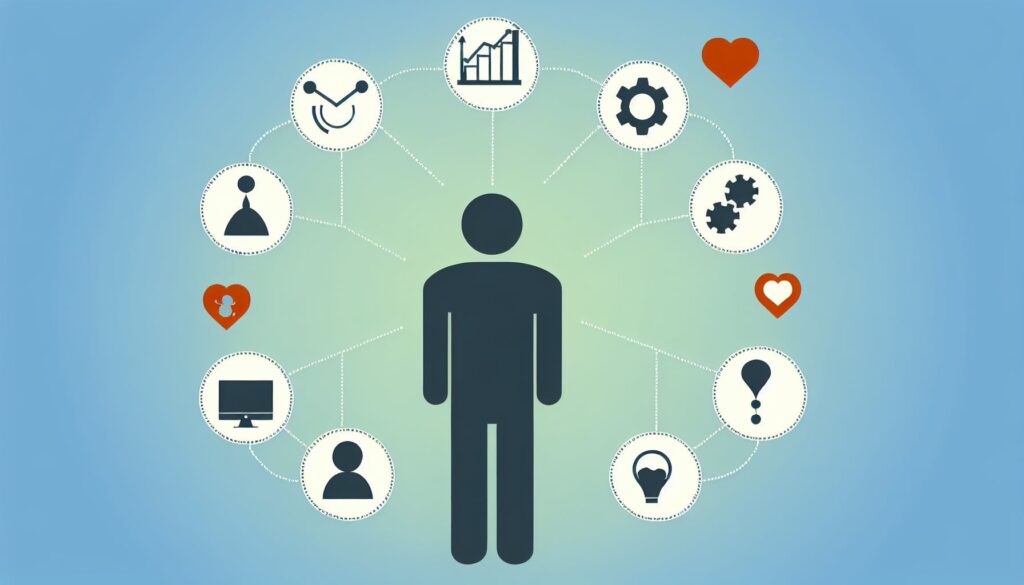Budding data analysts will agree – determining the requisite skills can be daunting when first venturing into this exciting field.
By clearly outlining the technical proficiencies and analytical thinking vital for data analysis, this guide illuminates the path forward.
You’ll discover the key qualifications needed, from SQL mastery to Python programming and statistics, as well as the soft skills that enable impactful data storytelling. Actionable strategies help develop proficiency to launch your analytics career.
Entering the World of Data Analytics
Data analysis is the process of inspecting, cleaning, transforming, and modeling data with the goal of discovering useful information, informing conclusions, and supporting decision-making. Data analysts apply critical thinking, statistical methods, and programming skills to uncover insights hidden within data sets.
The role of a data analyst is to collect, organize and study data to provide business leaders with data-driven recommendations. Data analysts are tasked with interpreting data and analyzing results using data visualization tools and statistical techniques, then communicating findings to stakeholders to influence strategic business decisions.
With data driving today’s world, the demand for data analytics skills is soaring. As companies increasingly rely on data to operate efficiently and gain a competitive edge, data analyst roles are fast becoming one of the hottest jobs in the industry.
Introduction to Data Analytics: A Career Overview
Data analysis encompasses a variety of technical skills, including:
- SQL and relational databases to store, organize, and query data
- R or Python programming for statistical analysis and data visualization
- Machine learning algorithms to uncover patterns and build predictive models
- Working with big data sets and cloud tools to glean impactful insights
Data analysts apply these technical abilities, along with analytical thinking, to extract meaning from data. The specific data analysis skills used depend largely on the industry. For example, financial analysts may build financial models to identify investment opportunities, while business analysts mine customer data to improve marketing campaigns.
No matter the role, data analysts are curious critical thinkers who use data to tell stories and derive actionable insights. Developing programming, statistical, and visualization skills opens the door to an array of potential career paths.
The Increasing Importance of Data Skills
Data skills are becoming fundamental literacies in today’s increasingly digital landscape. By 2025, IDC predicts worldwide data will grow 61% to 175 zettabytes. As data volume and variety accelerate, organizations are scrambling to extract meaningful insights to sharpen their competitive edge.
Consequently, demand for data analytics talent is booming. Recent reports estimate the market for big data and business analytics will expand by 15.6% CAGR to $420 billion by 2026. This torrent of data has created a pressing need for professionals who can translate numbers into tangible business value.
With companies betting big on data-driven decision making, data analysis skills open the door to countless opportunities. Whether you’re a new grad or mid-career switcher, developing analytics talents such as SQL, Python, statistical modeling, and data visualization will prepare you to capitalize on the analytics boom.
What qualifications do I need to be a data analyst?
To become a data analyst, you’ll usually need a bachelor’s degree or higher in a field like:
- Statistics
- Mathematics
- Economics
- Operational research
- Psychology
However, some employers may accept candidates with a combination of relevant work experience and non-degree data analytics certifications.
Here is a bit more detail on some common education paths to becoming a data analyst:
Formal Degree Programs
Getting a bachelor’s or master’s degree in a quantitative field like statistics, computer science, or information systems is the most common route. These programs equip you with skills in:
- Statistical analysis methods
- Programming languages like SQL, Python, and R
- Data visualization tools like Tableau
- Machine learning techniques
A master’s degree can give you an edge when job hunting. But a bachelor’s is often sufficient for many entry-level analyst roles.
Certificate Programs
Certificate programs in data analytics, data science, or business intelligence can also help qualify you for analyst jobs. Many are short courses focused on building job-ready data skills.
For example, edX and Coursera offer beginner-friendly certificate programs covering SQL, Excel, Tableau, and more. These can demonstrate your motivation to employers.
Developing In-Demand Skills
Alongside formal education, skills needed to become a data analyst like SQL, Python, statistical modeling, data visualization, and machine learning are hugely valuable.
You can build these skills through online courses, personal projects analyzing real data sets, and hands-on practice using analytical tools. Gaining practical experience will make you a strong applicant.
The mix of technical abilities and "soft" skills like communication and critical thinking are what make a well-rounded, hireable data analyst.
What do I need to start as a data analyst?
Becoming a data analyst requires developing both technical and analytical skills. Here is an overview of the key things you need to get started:
Technical Skills
- SQL – To query and manipulate databases
- Python or R – For statistical analysis and data visualization
- Spreadsheets – Excel is commonly used for basic data tasks
- Data visualization – Tools like Tableau to visualize and present data
Analytical Skills
- Statistics – Analyzing and interpreting quantitative data
- Problem-solving – Designing processes to organize, clean, transform data
- Communication – Explaining analytical findings to stakeholders
Hands-on Experience
- Real-world projects – Practice techniques on actual datasets
- Portfolio – Curate work samples showcasing your abilities
Gaining proficiency in these areas through coursework, self-study, and practical experience will equip you with the core competencies needed to succeed as a data analyst. Consider getting certified or pursuing higher education to further enhance your skillset. With dedication and hard work, you can develop the technical aptitude and analytical acumen required for the job.
How do I become a data analyst with no experience?
Becoming a data analyst without prior experience may seem daunting, but it is achievable through dedication and skill-building. Here are some practical steps to get started:
Acquire Relevant Skills
- Learn SQL to query and analyze data from databases
- Study statistics to interpret data and identify significant insights
- Master data visualization tools like Tableau to present data effectively
- Take online courses in Python or R programming for data analysis tasks
- Understand machine learning algorithms used for predictive analytics
Gain Hands-On Experience
- Complete data analysis projects using real-world datasets from Kaggle or other sources
- Volunteer to analyze data for nonprofits to build your portfolio
- Consider an internship at a tech company to learn on the job
Build a Portfolio
- Create a professional website showcasing your projects
- Include interactive Tableau dashboards and R/Python notebooks
- Demonstrate your skills in statistical analysis, data wrangling, visualization
Network and Seek Opportunities
- Attend local data science meetups to connect with professionals
- Join LinkedIn groups and follow influencers in the field
- Consider transitional roles like data analyst internships
The path to becoming a data analyst without prior professional experience requires dedication through self-motivated learning, portfolio building, and networking. But for those willing to hone technical skills with data tools and demonstrate their abilities, it is an achievable goal.
sbb-itb-0c864d8
Is Python required for data analyst?
Python is not an absolute requirement for a career in data analysis, but having Python skills will make you a much stronger candidate and better equipped to perform critical data analysis tasks. Here’s an overview of the key reasons why Python is highly recommended for aspiring data analysts:
Useful Python Libraries for Data Analysis
Python has many specialized libraries and frameworks designed specifically for data manipulation, statistical modeling, machine learning, and data visualization. Some of the most popular ones include:
- Pandas – for working with tabular data and time series
- NumPy – for numerical and scientific computing
- SciPy – for advanced mathematics and statistical tests
- scikit-learn – for machine learning tasks
- Matplotlib – for generating plots and graphs
- Seaborn – for statistical data visualization
Equipping yourself with these Python libraries will allow you to efficiently perform common data preparation, analysis, and visualization tasks.
Automation and Scalability
Python scripts can automate repetitive analysis and reporting workflows. This allows data analysts to focus on higher-value tasks like data interpretation, decision making, and strategy.
Python also readily handles large datasets and scales well with big data pipelines. This enables more powerful analysis than spreadsheets can offer.
Transferable Skills
While Python may not be universally required, mastering it equips you with broadly useful programming knowledge. This will enable you to more easily pick up other languages like R or SQL based on employer needs.
Overall, taking time to learn Python will provide long-term value for advancing your data analysis skills and career prospects. The effort invested will pay dividends even if a specific role does not mandate Python expertise.
Core Analyst Technical Skills for Data Analysis
This section outlines key technical proficiencies needed for a career in data analytics, including programming, statistics, data visualization, machine learning, and ability to work with big data infrastructure.
Mastering SQL and Relational Databases
SQL skills are critical for extracting and organizing data from databases. Analysts need to be able to write SQL queries to gather, join, aggregate, and transform data. Key skills include:
- Understanding database structures and relationships
- Writing
SELECTstatements to extract data - Filtering data with
WHEREclauses - Combining data from multiple tables using
JOIN - Grouping and aggregating data with
GROUP BY - Utilizing analytical functions like
SUM(),AVG(), etc.
Mastering these fundamental SQL concepts enables analysts to efficiently organize and analyze large datasets stored in relational databases.
Programming Proficiency in R or Python
Python and R are the most used programming languages for data analysis and manipulation. Analysts use them for tasks like data cleaning, analysis, visualization, and modeling. Required skills include:
- Importing, cleaning, transforming datasets
- Statistical analysis and modeling
- Data visualization using ggplot2, matplotlib etc.
- Machine learning with scikit-learn, TensorFlow etc.
- Writing functions and scripts to automate workflows
Learning R or Python helps analysts apply advanced analytical techniques to uncover insights. These skills are highly valued in data teams.
Applying Probability and Statistics in Data Analysis
Data analysts need statistical skills like distributions, hypothesis testing, regression, classification, and clustering to model data and deliver insights through machine learning. Key knowledge areas:
- Probability distributions
- Statistical significance testing
- Correlation and regression modeling
- Supervised models like logistic regression and random forests
- Unsupervised techniques like K-means clustering
Statistical prowess empowers analysts to accurately model complex data behaviors and relationships.
Navigating Big Data Sets with Hadoop and Spark
As data grows exponentially, understanding big data tools like Hadoop, Spark, cloud infrastructure, and distributed computing enables analysts to work at scale. Must-have skills include:
- SQL querying systems like Hive and Impala
- Building data pipelines with Spark
- Leveraging cloud platforms like AWS, GCP and Azure
- Applying concepts like parallelism and partitioning
Big data abilities allow analysts to unlock value from massive, rapidly growing datasets.
Crafting Compelling Stories with Data Visualization
Strong data visualization skills using leading business intelligence tools effectively convey analytical insights through interactive dashboards and reports. Key capabilities:
- Data wrangling and analysis in Power BI, Tableau etc.
- Designing insightful graphs, charts and visuals
- Building interactive dashboards with filters/tooltips
- Storytelling by contextualizing data
Data visualization aptitude empowers analysts to translate data into impactful, accessible narratives for stakeholders.
The Crucial Soft Skills for Data Analysts
Beyond technical ability, data analysts require several critical soft skills and analytical thinking capabilities to deliver impactful insights.
Cultivating Analytical Thinking for Problem-Solving
Data analysts need strong critical thinking abilities to frame problems, synthesize data, discern patterns, and develop data-driven solutions to complex business challenges. Key aspects include:
- Asking the right questions to deeply understand the business context and desired outcomes
- Approaching problems with an investigative mindset to uncover root causes and explore data from multiple angles
- Identifying connections and patterns across disparate data sources to reveal key insights
- Translating analytical findings into actionable recommendations that solve real-world problems and drive business impact
Sharpening analytical thinking takes consistent practice in framing problems, analyzing data, and synthesizing findings. Analysts should seek out opportunities to take on complex, open-ended business challenges that stretch their problem-solving skills.
Enhancing Communication through Data Storytelling
Analysts must contextualize and clearly communicate analytical findings to non-technical stakeholders through compelling data stories and visualization. Key aspects include:
- Structuring narratives that capture attention and explain the business significance
- Simplifying complex concepts using analogies, examples, and visuals
- Designing insightful data visualizations that quickly convey key patterns and trends
- Tailoring messaging and style for the audience and communication medium
Data storytelling is an essential capability for making analytics accessible and impactful. Analysts should continually hone their ability to craft context-specific data stories, translating technical findings into convincing narratives for business executives.
Fostering Creativity and Business Insight
Blending creativity with business sense enables analysts to deeply understand company needs, devise innovative solutions, and focus on key business outcomes. Key aspects include:
- Immersing in the company’s operations and objectives to intimately understand the business domain
- Approaching problems with an open and innovative mindset to uncover creative data solutions
- Prioritizing solutions that drive measurable business impact, rather than just technical elegance
- Collaborating closely with stakeholders across functions to ensure alignment on desired outcomes
Cultivating business acumen and creative thinking allows analysts to move beyond narrow technical tasks and instead function as strategic advisors driving data-centric decision making. Analysts should actively strengthen their business IQ across various functions to spur creative, high-impact analytics.
Strategies to Develop Data Analysis Skills
For aspiring and current data analysts seeking to level up their skills, here are practical methods to build proficiency:
Pursuing IBM Data Analytics with Excel and R Professional Certificate
Structured online programs like the IBM Data Analytics Certificate help develop technical abilities and proficiency using leading data analytics tools such as Excel and R. Key skills covered include:
- Statistical analysis and visualization using R
- Data manipulation, analysis, and visualization with Excel
- Building dashboards and interactive reports
- Machine learning fundamentals
- Data wrangling, querying, and exploration skills
Earning this certificate demonstrates core competencies needed by data analysts and can improve career prospects.
Engaging in Personal Projects to Hone Data Analytics Skills
Hands-on application through self-directed data analysis projects using public datasets sharpens skills and allows you to demonstrate capabilities to employers. Ideas include:
- Find an interesting dataset and ask/answer questions using data visualization and statistics
- Build a dashboard in Tableau tracking a personal metric over time
- Use Python or R to apply machine learning algorithms to make predictions
- Create an interactive report/app around a topic that interests you
Documenting and showcasing these projects, such as on GitHub, builds a portfolio highlighting data skills.
Learning from the Experience of Data Analytics Professionals
Joining data analytics networks, finding mentors, and learning best practices from experts accelerates practical skill-building. Ways to connect include:
- Attend local data analytics meetups to exchange ideas
- Follow data analysts on Twitter and read their blogs/newsletters
- Reach out to data professionals on LinkedIn for informational interviews
- Get involved with data analytics groups on Slack/Discord
Tapping this collective knowledge helps stay on top of latest industry advancements and techniques.
Conclusion: Synthesizing Skills for a Successful Data Analyst Career
In summary, modern data analysts need to cultivate a diverse set of technical and soft skills. While tools and technologies will continue to evolve, developing core competencies in areas like statistical modeling, data visualization, communication, and critical thinking will future-proof your career.
Recap: In-Demand Skills for Today’s Data Analysts
To succeed as a data analyst today, you need a solid foundation across several key technical areas:
- Programming with Python/R
- SQL for working with relational databases
- Statistical modeling and machine learning algorithms
- Big data platforms like Hadoop and Spark
- Data visualization tools like Tableau
These skills allow analysts to wrangle, model, interpret, and clearly present data insights. Mastering them takes diligent practice.
Soft Skills: The Differentiators in Data Analysis
While technical expertise is mandatory, soft skills separate exceptional analysts:
- Analytical thinking to deeply understand root causes in data
- Communication skills to explain insights to stakeholders
- Creative problem-solving abilities
- Business acumen to align analysis with organizational goals
Sharpening these "people skills" dramatically improves an analyst’s impact and career advancement. Technical skills open doors, but soft skills determine how far analysts can go once inside.
Related posts
- Requirements to Become a Data Analyst: Core Skills
- Skills Needed to Be a Data Analyst: Core Competencies Unveiled
- Skills Required to Become a Data Analyst: Your Ultimate Guide
- Become a Data Analyst: Essential Skills Overview

Tech Writer | Data Analyst | Digital Creator



